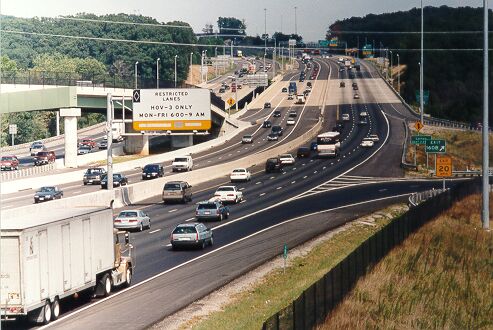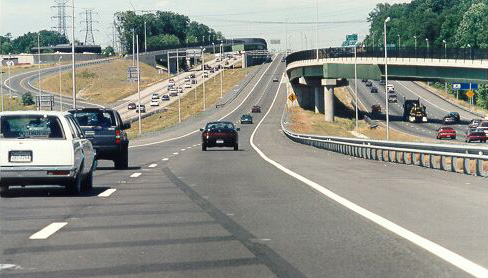
| Virginia Freeway HOV Lanes |
Virginia has 113 miles of freeway HOV lanes, with 73 miles in Northern Virginia, and 40 miles in the Norfolk/Hampton Roads area. High-Occupancy Vehicle (HOV) lanes are highway lanes that are restricted to vehicles with a certain number of persons, for instance, an HOV-3 lane would be restricted to vehicles that have at least 3 people in them. Some HOV lanes are concurrent-flow (a left "diamond" lane), and others are completely barrier-separated. Usually but not always, an HOV lane is restricted during peak hours and open to all vehicles in non-peak hours.

I-95, looking northbound, taken August
1997, from VA-123 overpass at Woodbridge. Notice the bridge where I-95 crosses
the Occoquan River; it is 868 feet long, and 11 lanes wide (8 through lanes).
The center roadway is the reversible roadway that carries HOV-3 traffic during
peak hours.

I-95 near Dale City, looking north, photo taken
June 1997. The center reversible roadway was extended from Springfield to Dumfries,
19 miles; construction spanned from 1990 to 1997, cost was about $305 million.
It carries HOV-3 traffic in the rush hour direction, unrestricted traffic otherwise.
This section of I-95 was originally completed in 1965 and is actually south of
the Shirley Highway portion. Notice the crossover ramps from each general-purpose
roadway to the reversible roadway. "HOV-3" means that High Occupancy Vehicles
with three or more people can use the road; those with fewer cannot.
I-66 in Northern Virginia
has 18 miles of an HOV-2 inner diamond lane each way from west of VA-234 at Manassas to I-495 Capital Beltway, and 9.6 miles of 2-lane exclusive HOV-2 in peak hours in peak direction, from I-495 to Rosslyn. I-66 from Rosslyn, across the Theodore Roosevelt Bridge, to its terminus in D.C. (about 1.5 mile) does not have HOV facilities. Dulles Airport SOV (single occupancy) traffic can use the highway at all times from Rosslyn to the Dulles Airport Access Road (DAAR). The eastern 3 miles of the DAAR is part of this HOV facility.VA-267 Dulles Toll Road in Northern Virginia
has15 miles of left diamond HOV-2 lanes.I-64 in Norfolk
has a 8-mile-long 2-lane barrier-separated reversible roadway for peak period HOV-2 traffic, and another 7 miles of left diamond HOV-2 lanes.I-564 in Norfolk
has 3 miles of left diamond HOV-2 lanes.I-264 Norfolk-Virginia Beach Expressway
(old VA-44) has 10 miles of left diamond HOV-2 lanes.I-264 in Norfolk
has 5 miles of left diamond HOV-2 lanes.I-64 in Newport News and Hampton
has 7 miles of left diamond HOV-2 lanes, with another 2.5 miles of left diamond HOV-2 lanes under construction to be completed in 2005.The initial 11 miles of the reversible Shirley Highway busway opened in 1970, from Springfield to D.C., allowing express bus traffic in the rush-hour direction of traffic. This was the first such facility on a freeway in the nation.
In both metropolitan areas, major lengths of new freeway HOV lanes are planned, on I-95 extended south to Fredericksburg, on I-66 extended west to Gainesville, on I-64 extended west to Williamsburg, on I-64 extended west in Chesapeake, and on the Hampton Roads Third Crossing, and the Third Crossing would interconnect the I-64 HOV lanes on the Peninsula and in South Hampton Roads.
In all these existing HOV facilities, HOV lanes were added to an existing freeway, no existing general-purpose lanes were taken away. These Virginia HOV lanes move a tremendous volume of passengers in busses, car pools and van pools. Other areas can learn from Virginia's example.
Future of HOV Lanes in Hampton Roads Area
There is a move underway to do away with the 40 miles of Interstate highway
HOV-2 lanes in the Hampton Roads area on I-64, I-264, and I-564, and convert them
to general-purpose lanes. These highways are in the cities of Norfolk, Virginia
Beach, Chesapeake, Newport News and Hampton. Critics say that they are only 1/3
full during peak hours.
I am opposed to this initiative! While the present use may indicate such a move,
I think that it would be very short sighted. These lanes should be given
at least 10 more years to prove themselves, since the last 2 legs in South Hampton
Roads were recently completed (I-64 in Chesapeake, 1997; and I-264 in Norfolk,
2000). Additional park-n-ride lots can be built, and new express bus lines can
be implemented.
The Virginia General Assembly passed legislation in the 1999 session to eliminate the HOV restrictions on these highways
and open those lanes to unrestricted traffic. The effort came strictly from Hampton
Roads area members of the General Assembly as well as their locally-elected officials. The Hampton
Roads area local consensus has for the most part turned against the HOV lane concept.
VDOT has had to take a neutral position on the matter, accede to the wishes of
Hampton Roads area citizens, and then take it to the Federal Highway Administration
(FHWA) to see if Virginia could get a waiver on the $170 million in federal highway
trust funds spent on widening the highways to provide the South Hampton Roads HOV system. These were
special federal Highway Trust Fund (HTF) funds that were for the purpose of building
HOV lanes and other transit-oriented highway improvements. As it stands now, Virginia
will have to pay back the $170 million to the feds if they eliminate the HOV restrictions.
Naturally, that would have a large financial impact on the state. So the HOV lanes
are still in effect.
New Jersey got a similar waiver on similarly funded HOV lanes (I-80 and I-287),
but that doesn't mean the Virginia and other states should get permission to do
the same.
The 2-lane reversible HOV roadway on I-64 from I-264 to I-564 is the heart
of the system, and the other 1-lane concurrent flow left HOV lanes are the "branches".
HOV service runs east-west on I-264 from downtown Norfolk almost to the Oceanfront in Virginia
Beach, and north-south along the I-64 Hampton Roads Beltway from near I-464, to
the I-64/I-564 junction at Wards Corner and along I-564 into Navy Base Norfolk.
The junction between the two highways at I-64/I-264 near Military Circle has an HOV reversible directional flyover ramp to connect the Virginia Beach leg to the Navy
Base leg.
It's really a well-planned and well-designed HOV system, but critics say that
not enough people use it, and that more traffic could be moved with the HOV lanes
converted to general purpose lanes. Maybe so for now, but since the Norfolk-Virginia
Beach light rail line was voted down in the Nov. 1999 election referendum, I think
that the HOV system should be kept for present and future mass transit needs,
for car pools, van pools, and express buses.
Links to Virginia HOV Material
TRAFFIX: Southeastern Virginia's Transportation Resource - a website with HOV information for the Norfolk/Hampton Roads area, on the Hampton Roads Transit website. TRAFFIX is a cooperative public service designed to promote transportation alternatives. Its objective is to decrease traffic congestion in Southeastern Virginia by reducing the number of Single Occupancy Vehicles (SOVs) commuting to work sites. TRAFFIX is active on two levels, working with both employers and employees. See these links: HOV Lanes and a maps of the HOV System Small Map and HOV System Large Map.
Virginia HOV Systems - details about the HOV facilities on the official VDOT website.
VDOT HOV Calculator for Northern Virginia, by VDOT. Everybody has heard that HOV lanes save time.. but have you ever wondered how much time they could save you? Now is your chance to find out. This calculator will show you how many minutes your morning commute will take by using a park-and-ride lot to access the carpool (HOV) lanes.
SlugVirginia and - Slug-Lines - Free Commuter Carpools - Slugging is not exactly hitchhiking but not quite a carpool. Some call it "Casual Carpooling". This unique method of commuting in Northern Virginia thrives without government regulation. The process is quite simple. People need extra riders to qualify for the minimum occupancy threshold to get into the High Occupancy Vehicle (HOV) lanes and other folks need a ride to work. Riders line up in lines at bus stops called Slug Lines and drivers pick up those going to their destination.
HOV Map - Transportation - Fairfax County, Virginia, from HOV Lanes - Transportation - Fairfax County, Virginia, by Fairfax County, Virginia.
See my articles for more details about HOV facilities:
Henry G.
Shirley Memorial Highway
Springfield Interchange Project
Interstate 66 and Metrorail Vienna Route
Washington D.C. Area Interstate HOV is a Success
Hampton Roads Area Interstates and Freeways
I-64 Widening
Projects in Newport News and Hampton
Hampton Roads Crossing Study
Interstate Highway System in Virginia -
I-64,
I-66, I-95,
I-264, I-395,
I-495, I-564,
I-664
MWCOG last released its annual HOV performance report in 1999, so my "Washington D.C. Area Interstate HOV is a Success" article reflects that data, which is now a bit dated. From what I understand, regional political machinations have prevented the public release of the more current reports.
All photos taken by Scott Kozel.
Copyright © 1997-2004 by Scott Kozel. All rights reserved. Reproduction, reuse, or distribution without permission is prohibited.
By Scott M. Kozel, Roads to the Future
(Created 12-24-1997, updated 3-1-2004)